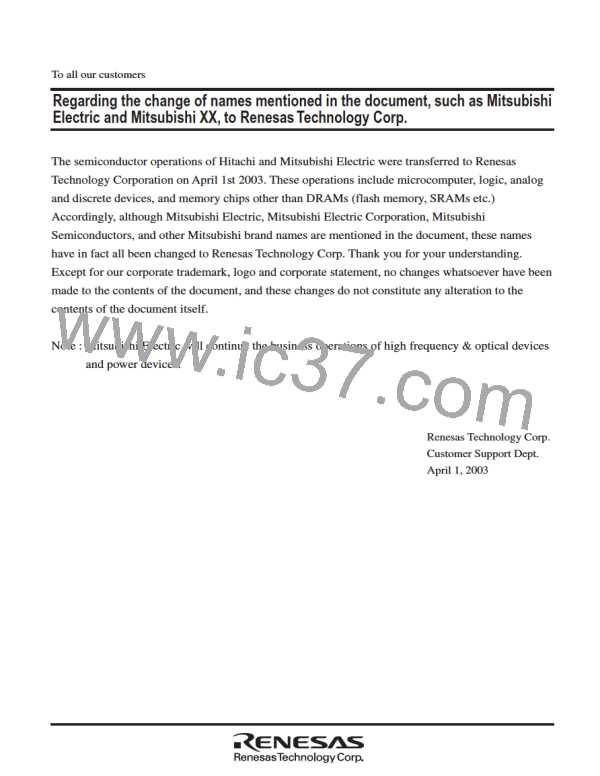MITSUBISHI MICROCOMPUTERS
7470/7471 Group
SINGLE-CHIP 8-BIT CMOS MICROCOMPUTER
BUILT-IN PROM TYPE MICROCOMPUTERS
PIN DESCRIPTION
Input/
Output
Pin
Mode
Name
Functions
VCC,VSS
Single-chip Power source
/EPROM
Power source voltage inputs 2.7 to 5.5 V to VCC and 0 V to VSS.
AVSS
Single-chip Analog power
Ground level input pin for A-D converter. Same voltage as VSS is applied.
(Note 1)
/EPROM
source
RESET
Single-chip Reset input
Input To enter the reset state, the reset input pin must be kept at a “L” for 2 µs or more
(under normal VCC conditions).
EPROM
Reset input
Connect to VSS.
XIN
Single-chip Clock input
/EPROM
Input These are I/O pins of internal clock generating circuit for main clock. To control
generating frequency, an external ceramic or a quartz-crystal oscillator is con-
nected between the XIN and XOUT pins. If an external clock is used, the clock
Output source should be connected the XIN pin and the XOUT pin should be left open.
Feedback resistor is connected between XIN and XOUT.
XOUT
VREF
Clock output
Single-chip Reference
voltage input
Input Reference voltage input pin for the A-D converter.
EPROM
Select mode
Input
I/O
VREF works as CE input.
P00–P07
P10–P17
Single-chip I/O port P0
Port P0 is an 8-bit I/O port. The output structure is CMOS output. When this port
is selected for input, pull-up transistor can be connected in units of 1-bit and a key
on wake up function is provided.
EPROM
Data input/output D
0–D
7
I/O
I/O
Port P0 works as an 8-bit data bus (D0–D7).
Single-chip I/O port P1
Port P1 is an 8-bit I/O port. The output structure is CMOS output. When this port
is selected for input, pull-up transistor can be connected in units of 4-bit. P12, P13
are in common with timer output pins T0, T1. P14, P15, P16, P17 are in common
with serial I/O pins SIN, SOUT, CLK, SRDY, respectively. The output structure of
SOUT and SRDY can be changed to N-channel open drain output.
EPROM
Address input A
4–A10
Input
I/O
P11–P17 works as the 7-bit address input (A4–A10). P10 must be opened.
P20–P27
(Note 2)
Single-chip I/O port P2
Port P2 is an 8-bit input port. This port is in common with analog input pins IN0–IN7.
EPROM
Address input
A0–A3
Input P20–P23 works as the lower 4-bit address input (A0–A3).
P24–P27 must be opened.
P30–P33
Single-chip Input port P3
Input
Input
Port P3 is a 4-bit input port. P3
0
, P3
1
are in common with external interrupt input
, CNTR
pins INT , INT and P3 , P3 are in common with timer input pins CNTR
0
1
2
3
0
1.
EPROM
Address input
A11, A12
P30, P31 works as the 2-bit address input (A11, A12).
P32 works as OE input. Connect to P33 to VPP when programming or verifying.
Select mode
VPP input
P40–P43
(Note 3)
Single-chip I/O port P4
I/O
Port P4 is a 4-bit I/O port. The output structure is CMOS output. When this port is
selected for input, pull-up transistor can be connected in units of 4-bit.
EPROM
Address input
A13, A14
Input
P40, P41 works as the higher 2-bit address input (A13, A14).
P42, P43 must be opened.
P50–P53
(Note 4)
Single-chip Input port P5
Input Port P5 is a 4-bit input port and pull-up transistor can be connected in units of 4-
bit. P50, P51 are in common with input/output pins of clock for clock function XCIN,
XCOUT. When P50, P51 are used as XCIN, XCOUT, connect a ceramic or a quartz-
crystal oscillator between XCIN and XCOUT. If an external clock input is used, con-
nect the clock input to the XCIN pin and open the XCOUT pin. Feedback resistor is
connected between XCIN and XCOUT pins.
EPROM
Open.
Notes 1 : AVSS for M37471M2/M4/M8/E4/E8-XXXFP.
2 : Only P20–P23 (IN0–IN3) 4-bit for the 7470 group.
3 : Only P40 and P41 2-bit for the 7470 group.
4 : This port is not included in the 7470 group.
34

 ETC [ ETC ]
ETC [ ETC ]